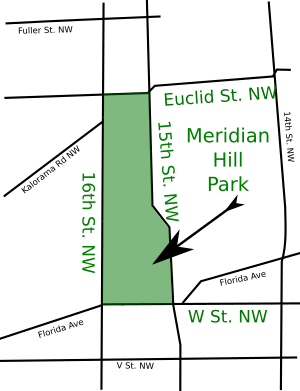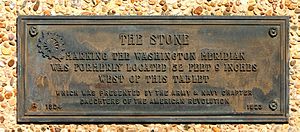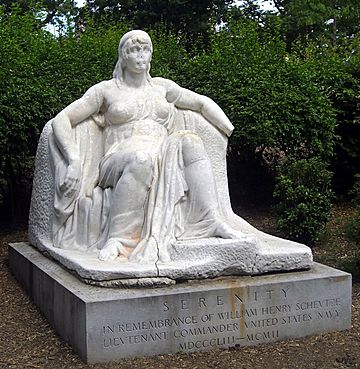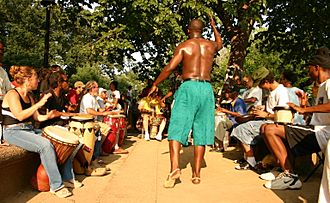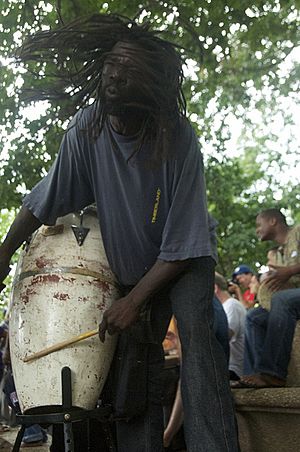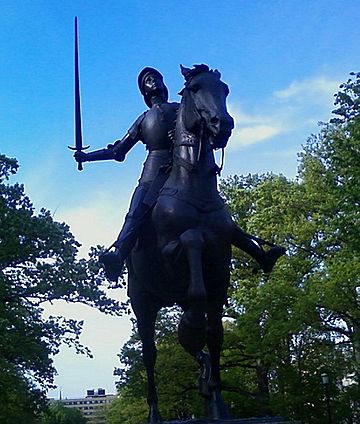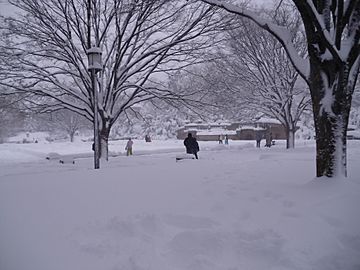Meridian Hill Park facts for kids
|
Meridian Hill Park
|
|
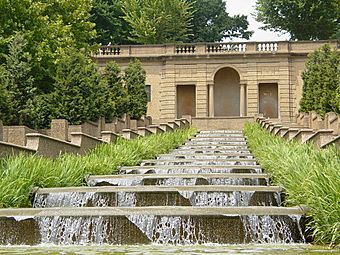
A thirteen-basin cascade fountain is one of the more dramatic features of Meridian Hill Park
|
|
| Location | Bounded by 16th, Euclid, 15th, and W Sts., NW. Washington, D.C. |
|---|---|
| Architect | George Burnap and Horace Peaslee |
| NRHP reference No. | 74000273 |
Quick facts for kids Significant dates |
|
| Added to NRHP | October 25, 1974 |
| Designated NHL | April 19, 1994 |
Meridian Hill Park is a beautiful park in Washington, D.C.. It's located in the Columbia Heights neighborhood, right next to Adams Morgan. This park was designed and built between 1912 and 1940. It's about 12 acres (49,000 m2) in size and is known for its formal gardens.
The park is part of the National Capital Parks system, managed by the National Park Service. It's bordered by 15th, 16th, W, and Euclid streets NW. The park sits on a tall hill, about 1.5 miles (2.42 km) north of the White House. Since 1969, some local people have also called it "Malcolm X Park."
Contents
History of Meridian Hill Park
When Washington, D.C., was first created in 1791, the land where Meridian Hill Park now stands was owned by Robert Peter. It was known as Peter's Hill. In 1804, President Thomas Jefferson placed a special marker on this large hill. This marker was exactly north of the White House. It helped create a special line, called the "White House meridian," for mapping the city and the country.
From Private Estate to Public Park
After the War of 1812, a naval hero named Commodore David Porter bought the hill in 1816. He named his new property Meridian Hill. Porter built a large, famous mansion on the hill, also called Meridian Hill. From his home, he had an amazing view of the White House and the Potomac River. Meridian Hill Park still offers this view today.
During the Civil War, the Meridian Hill estate became an army camp called Camp Cameron. It was a strategic spot because it overlooked the city. After the war, the mansion was badly damaged by fire and later torn down. In 1867, the land was divided into smaller lots.
In 1887, a wealthy couple from Missouri, former Senator John Brooks Henderson and his wife Mary Foote Henderson, moved to D.C. They bought many of these lots. The Hendersons built a large stone home, like a castle, on 16th Street. It was known as Henderson Castle.
Mary Henderson had big plans for the area. She wanted to build a huge presidential mansion on Meridian Hill. When that didn't happen, she suggested the site for the Lincoln Memorial. These ideas didn't work out either.
Creating a Grand Park
Mary Henderson then focused on creating a public park. She also used her own money to build many large, fancy embassies and mansions along 15th and 16th streets. These buildings still stand today and give the area around the park a grand look.
In 1901, a group called the Senate Park Commission helped reshape Washington, D.C. They decided that a park on Meridian Hill was a good idea. Mary Henderson strongly supported the park. For many years, she worked hard to get Congress to provide money to finish the project.
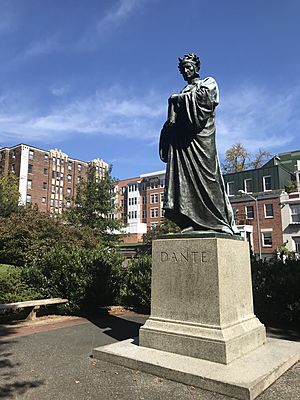
Congress officially created Meridian Hill Park on June 25, 1910. The government bought the land that same year. In 1912, they hired landscape architect George Burnap to design a grand park, like those in European cities. His plans were approved in 1914 and later changed by Horace Peaslee.
The design included a beautiful Italian Renaissance-style terraced fountain with pools. It also had gardens in a French Baroque style. The upper part of the park was later made simpler, creating an open space for gatherings.
The park's walls, fountains, and benches were built using a special concrete technique. This method was created by a skilled craftsman named John Joseph Earley. He and his team worked for years on the park. After two decades of construction, the park was mostly finished and opened in 1936. It quickly became a popular spot for city residents.
Park Life and Restoration
The upper part of the park was often used for concerts and events. In 1969, activist Angela Davis suggested renaming the park Malcolm X Park, but this name change was not approved. In the 1970s, the park faced some challenges, including crime and vandalism.
Around 1990, local residents got involved to help the park. A group called the Friends of Meridian Hill was formed. They organized patrols to reduce crime, planted trees, and held community events. These events included concerts and educational programs. In 1994, President Bill Clinton honored the Friends of Meridian Hill for their efforts.
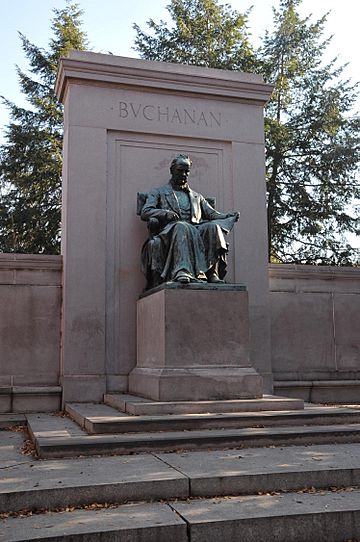
Since 2005, the National Park Service has been working to restore the park. They are carefully repairing the unique concrete structures and updating the park's systems. This ongoing work helps keep the park beautiful for everyone.
Today, Meridian Hill Park is a well-loved place for local residents. On Sunday afternoons when the weather is warm, many people gather in the upper park. From 3 to 9 p.m., they dance and join in a Drum Circle. This activity has been happening in the park since the 1950s. It attracts both dancers and professional drummers.
In 1994, the park was named a National Historic Landmark. It was recognized as an "outstanding accomplishment" of park design from the early 1900s. The park is now maintained as part of Rock Creek Park. In 2014, the area around the park was also named the Meridian Hill Historic District.
Statues and Features
A main feature of Meridian Hill Park is the 13-basin Cascading Waterfall in the lower garden. The fountains use a special system that recycles water. Pumps send water to two large circular fountains on the upper level, which then flows down the cascade. The park has many walls and stairways that add to its interesting design. Since the park is on a hillside, some of the stairways are quite dramatic. You'll also find well-designed concrete benches, urns, and patterned walkways.
The park's design was meant to look like a formal Italian garden. The plants were chosen by landscape architects Vitale, Brinckerhoff, and Geiffert. In the past, gardens like this were usually only for rich people. But Meridian Hill Park was created for everyone to enjoy.
Notable Statues
Several beautiful sculptures and memorials are placed throughout the park. Some were even added while the park was still being built. These include:
- Serenity: This statue was made by sculptor Jose Clara (Josep Clarà i Ayats). It is carved from a single block of white marble and was dedicated in 1924. It honors Lt. Commander William Henry Scheutze of the U.S. Navy.
- Joan of Arc: This statue was a gift from the Ladies of France in Exile in New York in 1922. It celebrates the 510th anniversary of Joan of Arc's birth. It's a bronze copy of an 1889 statue by Paul Dubois. This is the only statue in Washington, D.C., that shows a woman on horseback.
- Dante: This 11.5-foot bronze sculpture was created by Ettore Ximenes in 1921. It stands on a green granite base. The statue shows the Italian poet Dante Alighieri dressed in a scholar's robe.
- James Buchanan Memorial: This memorial honors James Buchanan, the 15th president of the United States. It was sculpted by Hans Schuler and dedicated in 1930. This large, 82-foot-long memorial is the only one dedicated to James Buchanan in Washington.


